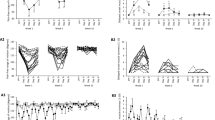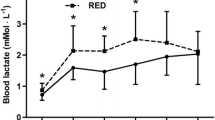Abstract
Eccentric muscle actions are known to induce temporary muscle damage, delayed onset muscle soreness (DOMS) and muscle weakness that may persist for several days. The purpose of the present study was to determine whether DOMS-inducing exercise affects blood lactate responses to subsequent incremental dynamic exercise. Physiological and metabolic responses to a standardised incremental exercise task were measured two days after the performance of an eccentric exercise bout or in a control (no prior exercise) condition. Ten healthy recreationally active subjects (9 male, 1 female), aged 20 (SD 1) years performed repeated eccentric muscle actions during 40 min of bench stepping (knee high step; 15 steps · min−1). Two days after the eccentric exercise, while the subjects experienced DOMS, they cycled on a basket loaded cycle ergometer at a starting work rate of 150 W, with increments of 50 W every 2 min until fatigue. The order of the preceding treatments (eccentric exercise or control) was randomised and the treatments were carried out 2 weeks apart. Two days after the eccentric exercise, all subjects reported leg muscle soreness and exhibited elevated levels of plasma creatine kinase activity (P < 0.05). Endurance time and peak V˙O2 during cycling were unaffected by the prior eccentric exercise. Minute volume, respiratory exchange ratio and heart rate responses were similar but venous blood lactate concentration was higher (P < 0.05) during cycling after eccentric exercise compared with the control condition. Peak blood lactate concentration, observed at 2 min post-exercise was also higher [12.6 (SD 1.4) vs 10.9 SD (1.3) mM; P < 0.01]. The higher blood lactate concentration during cycling exercise after prior eccentric exercise may be attributable to an increased rate of glycogenolysis possibly arising from an increased recruitment of Type II muscle fibres. It follows that determination of lactate thresholds for the purpose of fitness assessment in subjects experiencing DOMS is not appropriate.
Similar content being viewed by others

Author information
Authors and Affiliations
Additional information
Accepted: 27 September 1997
Rights and permissions
About this article
Cite this article
Gleeson, M., Blannin, A., Walsh, N. et al. Effect of exercise-induced muscle damage on the blood lactate response to incremental exercise in humans. Eur J Appl Physiol 77, 292–295 (1998). https://doi.org/10.1007/s004210050336
Issue Date:
DOI: https://doi.org/10.1007/s004210050336



